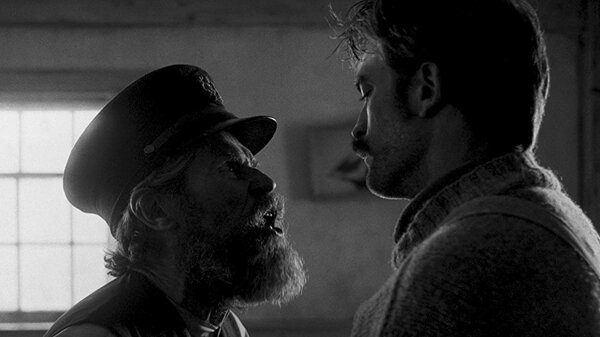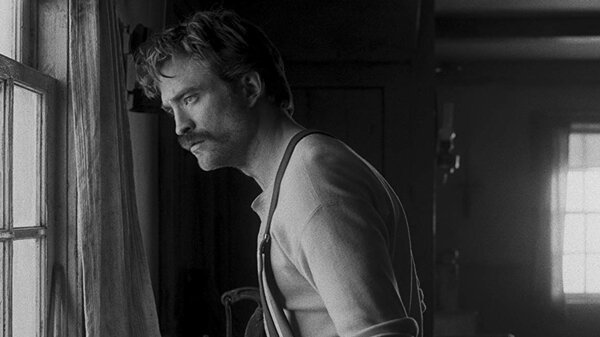Robert Eggers’ unhinged maritime folk tale places two men up close to one another and waits for the madness to unfold. In The Lighthouse, there’s deep mythology and omnipresent subtext – from historic superstition to vivid sexual tension. Steph Green dives into the murky waters of masculine horror.
“No sign is left of all the town/ Except a few forgotten graves;/ But to and fro the white sails go/ Slowly across the glittering waves”
Sarah Orne Jewett, a Maine-based writer known for her poems and novels set on the US Eastern seaboard at the turn of the 20th century, often invoked the power, mania and isolating nature of the ocean in her works – as articulated in the above lines from “On Star Island”. Using these seaweed-strewn vignettes of seafaring life as explicit inspiration for the poetic maritime dialogue in The Lighthouse, Robert Eggers drew upon this woman’s voice in a film that, bar the fleeting appearances of a mermaid with warped genitals, contains a distinct lack of female presence. What ripples on the surface of the tale is the idea that this is a film about two men, and their oscillating tensions around a very phallic structure. “It was pretty explicit in the script. The script said the lighthouse looked like an erect penis,” co-star Robert Pattinson said in his characteristic to-the-point manner in a HuffPost interview. And yet, as the saying goes, no man is an island. In all facets but visibly, womanly terror informs The Lighthouse in a myriad of ways, subverting the trope of the ‘monstrous-feminine’ so commonly found in horror film narratives.
In her 1993 book The Monstrous-Feminine, Barbara Creed takes aim at the portrayal of the victimised woman in horror whose bodies had been rendered monstrous, using Rosemary’s Baby and The Exorcist as two examples. Creed claims that Freud’s vision of the castrated woman, a woman whose body had ‘gone wrong’, was “a fantasy intended to ameliorate man’s real fear of what woman might do to him [...] he fears that woman could castrate him both psychically and, in a sense, physically.” This fantasy isn’t immediately apparent in The Lighthouse, an ostensibly male-dominated tale. Where women and their corrupt bodies were the target of erstwhile horror narratives, the focus has now shifted to two men. However, Ephraim (Pattinson) in particular is still tormented by a female apparition, one that is intrinsically linked to the ocean which surrounds him. A woman, non-corporeally, becomes a symbolic yet powerful adjudicator in The Lighthouse, instilling fear in men with merely metaphorical mythic power.
Eggers invites – nay, forces – the audience to gaze upon Thomas (Willem Dafoe) and Ephraim’s bodies, radically altering and redirecting our established ideas of to-be-looked-at-ness. Paul Schrader, while talking about his stylistic reasoning for shooting First Reformed in 4:3 aspect ratio, explained that this “drives the vertical lines, so you get more of the human body in the frame.” The Lighthouse’s 1.19 x 1 aspect ratio embraces this similarly oppressive vantage point, forcing more of the two wickies’ bodies into view; this technique also allows us to see more of the titular lighthouse, which is frequently shot paired with obvious imagery of orgasm as sea-spray explodes and spurts around it. A prevailing feeling exists that the two men are ill at ease with this overtly masculine landscape, one that has been shot specifically to feel claustrophobic, despite Thomas’ blind insistence that his beloved lighthouse is “a finer and quieter wife than any flesh-and-blood wife.” To bolster this mood of disequilibrium, Eggers employs another Schrader-esque posture in The Lighthouse. In his 1972 book Transcendental Style in Film, Schrader stated that transcendentalism’s spiritual malaise in film is forged through a “cold, unfeeling world” that is upended through the introduction of an “irrational and undefined” element. The cold and unfeeling world in The Lighthouse is established stylistically, yet Eggers’ bleak setting is ravaged further by the introduction of the ocean, a vast body of entrapping water that corrupts the characters, subsequently defiled by an irrational and undefined element: a mermaid.
“Sexuality in this movie is scary,” Eggers stated in an interview with Fortune. “If you're looking at what the mermaid is through the male lens, she's part of the sea, that most powerful force.” Historically, mermaids have held various metaphorical interpretations. An early myth of the first mermaid was of the goddess Atargatis, who turned herself into a mermaid out of shame for accidentally killing her mortal lover. Correspondingly, the alluring yet fearsome mermaid in The Lighthouse certainly feels like the manifestation of Ephraim’s own guilt for his lust towards Thomas, as well as foreshadowing the film’s later murderous turn. The nameless mermaid is beautiful but does little to satiate Ephraim, who is tormented by his own quiet and confusing attraction to Thomas, a posture which is built up through various voyeuristic moments. As Ephraim tries to fix a roof early in the film, he becomes transfixed by the view of Thomas lying face down, his hips subtly and slowly gyrating.
This senseless attraction often spills out into anger, with Ephraim spewing insults directly focused upon, in Kristevan terms, the male abject – one unforgettable line being “you smell like curdled foreskin.” The mermaid’s otherworldly magical aura results in Ephraim being drawn into treacherous waters – a scene that occurs just after Ephraim sees Thomas nude – wading into the cold sea in search for something he can’t quite seem to find. Ineloquent and angry, he projects his fears and neuroses onto this flawed, ersatz realisation of womanhood, both as a broken china figurine and a flesh-and-blood mermaid. But, when he eventually begins to copulate with the mermaid, he’s rudely interrupted by a vision of Thomas. These apparitions of the older wickie, coupled with the hentai-like, flailing tentacles that burst onto the screen at Ephraim’s point of climax, remind the audience, and himself, that the psychological toll he is suffering from is not caused by a woman at all. His desire to discover the otherworldly force emanating from the lighthouse, to expend his horny energy, is fuelled by a very male brand of arrogance, the desire to know everything about the things he is forbidden from knowing. By repositioning the monstrous-feminine from the centrefold to the margins, Eggers invites the audience to examine the root of Ephraim’s tortured psyche, for us to discover that the ocean is merely a tool to display his own inner weaknesses, his fears of his past crimes.
Constantly becoming stuck and unstuck to each other like octopus tentacles, to-ing and fro-ing like the rhythm of the tide, Ephraim and Thomas’ volatile relationship soon cannot even find refuge within the island’s buildings. As tension grows, their lodging becomes increasingly flooded by the ocean, penetrating Ephraim’s psyche, with sea water mixing with bodily fluid: vomit, semen, blood, urine. No matter how hard Ephraim had tried to fix the roof, water drips in, tauntingly. Shot in black and white, it’s sometimes unclear as to what kind of wetness we’re looking at in The Lighthouse, and all liquid soon becomes as dark and murky as squid ink. Cinematographer Jarin Blaschke shot the film on the Panavision Millennium XL2, augmenting his camera with vintage Baltar lenses, which have many unique characteristics – one being that “the water shimmers more.” Giving rise to the ocean’s presence in this way again shows how The Lighthouse was filmed with the sea in mind; even sound designer Damien Volpe mined sounds from the sea shore, placing tiny microphones inside conch shells – almost labial – to capture the dissonant noises of the sea that haunt the soundscape. Originally thought as a means to escape from the island, the ocean increasingly jibes at Ephraim, a moat of monstrosity he is condemned to suffer within. One of the opening shots shows Pattinson and Dafoe standing on a rock as rain and sea-spray whips around them violently. Ephraim is a little unsteady; Thomas remains stoic. It’s a nuanced clue as to who will fall victim to the folkloric mania of the sea.
The Lighthouse ends with Ephraim slumped on the rocky shore, dazed and unwell, as seagulls appear to be pecking him slowly to death. This grim ending recalls the myth of Prometheus, bound to a rock where each day an eagle is sent to eat his liver, only to grow back overnight and be eaten again the next day, all as punishment from the Gods for stealing fire. Ephraim’s punishment is resituated to the sea for his forbidden gazing into the light, yet still reflecting this parable of male arrogance. The sea laps at Ephraim’s ankles, mockingly. Despite the film’s brazen invocation of various problematic men, from Prospero to Bluebeard and Captain Ahab, The Lighthouse still manages to remain resolutely afloat in this sea of metaphor and myth. Why? According to Dafoe, the narrative hinges on two things: guilt and toxic masculinity. Two traits rooted firmly in contemporary reality. It’s a narrative aided along stylistically by a fearsome, female body of water, but it’s nonetheless all too recognisable.
As Jewett penned in ‘On Star Island’: “I know the blue sea covered som,/ And others in the rocky ground/ Found narrow lodgings for their bones/ God grant their rest is sweet and sound!”
Steph Green (@steph__green) is a freelance journalist from London who writes about film for New Statesman, Little White Lies, Vogue Paris and more. She edits the film news section of The Indiependent, eats a lot of spicy food and is very enthusiastic about the things she loves.





